Online Courses
Study in China
About Beijing
The Forbidden City
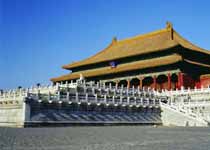 The Forbidden City, known as the Palace Museum, was the imperial palace of the Ming and Qing dynasties. In early 15th century, large-scale construction involved l00, 000 artisans and one million civilians. The construction took 14 years and was finished in 1420. In the following year, the capital of the Ming Dynasty was moved from Nanjing to Beijing. Twenty-four emperors of the Ming and Qing dynasties ruled from the Forbidden City. The last dynasty fell in 1911, but Emperor Puyi still lived in the inner court. It was not until 1925 that the complex was converted into a museum. Since then the palace has been opened to the public.
The Forbidden City, known as the Palace Museum, was the imperial palace of the Ming and Qing dynasties. In early 15th century, large-scale construction involved l00, 000 artisans and one million civilians. The construction took 14 years and was finished in 1420. In the following year, the capital of the Ming Dynasty was moved from Nanjing to Beijing. Twenty-four emperors of the Ming and Qing dynasties ruled from the Forbidden City. The last dynasty fell in 1911, but Emperor Puyi still lived in the inner court. It was not until 1925 that the complex was converted into a museum. Since then the palace has been opened to the public.
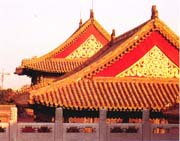 The Forbidden City is located in the center of Beijing, covering an area of 72 hectares. It is rectangular in shape, 960 meters long from north to south and 750 meters wide from east to west. There is a 10-meter-high wall, encircled by a 52-metre-wide moat. In the Ming Dynasty, the timber needed for building the palace was brought mostly from Sichuan, Hunan and Guizhou provinces, while in the Qing Dynasty, it was cut from northeast China. Most of the stones were quarried from the suburban district of Fangshan and other districts. Construction of the Forbidden City brought tremendous hardship to the laboring people.
The Forbidden City is located in the center of Beijing, covering an area of 72 hectares. It is rectangular in shape, 960 meters long from north to south and 750 meters wide from east to west. There is a 10-meter-high wall, encircled by a 52-metre-wide moat. In the Ming Dynasty, the timber needed for building the palace was brought mostly from Sichuan, Hunan and Guizhou provinces, while in the Qing Dynasty, it was cut from northeast China. Most of the stones were quarried from the suburban district of Fangshan and other districts. Construction of the Forbidden City brought tremendous hardship to the laboring people.
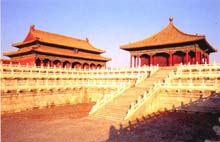 The Forbidden City is divided into southern and northern parts: the former served as the emperor's work area and the latter as his living quarters. The main structures are arranged along a central axis and the buildings on both sides of it are symmetrical. The three most imposing structures in the emperor's work area are the Hall of Supreme Harmony (Tai He Dian), the Hall of Central Harmony (Zhong He Dian), and the Hall of Protective Harmony (Bao He Dian). The three cover a combined area of 85,000 square meters. The most magnificent of them is the Hall of Supreme Harmony, which is 60.1meters wide, 33.33 meters deep and 35.05 meters high. Here the most important ceremonies of the feudal dynasties were held, including the emperor's ascension to the throne, his marriage, and his conferring of titles on officials. The Hall of Central
The Forbidden City is divided into southern and northern parts: the former served as the emperor's work area and the latter as his living quarters. The main structures are arranged along a central axis and the buildings on both sides of it are symmetrical. The three most imposing structures in the emperor's work area are the Hall of Supreme Harmony (Tai He Dian), the Hall of Central Harmony (Zhong He Dian), and the Hall of Protective Harmony (Bao He Dian). The three cover a combined area of 85,000 square meters. The most magnificent of them is the Hall of Supreme Harmony, which is 60.1meters wide, 33.33 meters deep and 35.05 meters high. Here the most important ceremonies of the feudal dynasties were held, including the emperor's ascension to the throne, his marriage, and his conferring of titles on officials. The Hall of Central 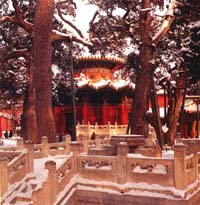 Harmony standing behind, is where the emperor rested before ceremonies and receiving officials. The Hall of Protective Harmony, the northern most structure, is where the emperor gave banquets and interviewed in person successful candidates of imperial examinations. In the living quarters are nine separate housing complexes, where the emperor and his family lived. North of the living quarters is a small imperial garden. Yang Xin Zhai, or Mind cultivation Hall, in the living quarters was there most Qing emperors lived and handled state affairs. It is also here that Empress Dowager Cixi attended to state affairs for 40 years.
Harmony standing behind, is where the emperor rested before ceremonies and receiving officials. The Hall of Protective Harmony, the northern most structure, is where the emperor gave banquets and interviewed in person successful candidates of imperial examinations. In the living quarters are nine separate housing complexes, where the emperor and his family lived. North of the living quarters is a small imperial garden. Yang Xin Zhai, or Mind cultivation Hall, in the living quarters was there most Qing emperors lived and handled state affairs. It is also here that Empress Dowager Cixi attended to state affairs for 40 years.
 Almost every detail in the Forbidden City has some symbolic meaning and reflects Chinese culture in one way or another. The layout of the palatial complex, whose full name is the Purple Forbidden City, is patterned after the legendary Heavenly Palace. In ancient Chinese astrology, the heavenly Purple Forbidden Enclosure centered around the North Star was thought of as the center of heaven. The palatial complex, regarded as being at the center of human society on earth, was therefore named Purple Forbidden City. The number nine received special emphasis the city design. The number of houses in the Forbidden City is 9,999; and nails on every door are arranged according to the same pattern: each line of nails, vertical or horizontal, contains nine nails. This is because the ancients regarded nine as the biggest number, to which only emperors were entitled. Also, since the numeral has the same sound as "everlasting" in the Chinese language, it best reflected the wish of emperors that their rule would last forever. Names of places in the Forbidden City contain such words as ren (benevolence), he (harmony) and an (peace). They reflect the essence of Confucianism. The predominant color of the Forbidden City is yellow. Nearly all the houses, for example, have roofs of yellow glazed tiles. According to ancient Chinese philosophy, the universe was made up of five elements: metal, wood, water, fire and earth, earth being the most basic of them all. As a result, yellow, the color of earth, was most extensively used for the emperors, who were regarded as the supreme rulers of humanity. The emperors also mostly wore yellow robes. The only house with a roof of black tiles is Wen Yuan Ge, or the royal library. This is because black represents the element water, and water can overcome fire, a constant threat to the collection of books inside.
Almost every detail in the Forbidden City has some symbolic meaning and reflects Chinese culture in one way or another. The layout of the palatial complex, whose full name is the Purple Forbidden City, is patterned after the legendary Heavenly Palace. In ancient Chinese astrology, the heavenly Purple Forbidden Enclosure centered around the North Star was thought of as the center of heaven. The palatial complex, regarded as being at the center of human society on earth, was therefore named Purple Forbidden City. The number nine received special emphasis the city design. The number of houses in the Forbidden City is 9,999; and nails on every door are arranged according to the same pattern: each line of nails, vertical or horizontal, contains nine nails. This is because the ancients regarded nine as the biggest number, to which only emperors were entitled. Also, since the numeral has the same sound as "everlasting" in the Chinese language, it best reflected the wish of emperors that their rule would last forever. Names of places in the Forbidden City contain such words as ren (benevolence), he (harmony) and an (peace). They reflect the essence of Confucianism. The predominant color of the Forbidden City is yellow. Nearly all the houses, for example, have roofs of yellow glazed tiles. According to ancient Chinese philosophy, the universe was made up of five elements: metal, wood, water, fire and earth, earth being the most basic of them all. As a result, yellow, the color of earth, was most extensively used for the emperors, who were regarded as the supreme rulers of humanity. The emperors also mostly wore yellow robes. The only house with a roof of black tiles is Wen Yuan Ge, or the royal library. This is because black represents the element water, and water can overcome fire, a constant threat to the collection of books inside.
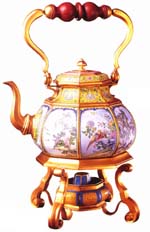 The Forbidden City, besides being a national treasure in and of itself, is a storehouse of numerous priceless handicraft articles, rare curios, paintings and calligraphic works by famous artists, official documents and historical records. In face, the City is China's largest museum and biggest treasure house. The Wen Hua Hall in the City stores more than 10 million official documents drawn up over 500 years by central and local governments of the Ming and Qing dynasties. They are the largest and most valuable collection of historical records in the country. The Imperial Library keeps the Si Ku Quan Shu, a 79,337-volume compendium of historical records and feudal rites compiled over ten years (1772-1781)by the nation's most accomplished scholars. Inside the Forbidden City today are more than ten museums. They are respectively for" ancient Chinese arts, arts and crafts,paintings, curios of the Qing court, bronze articles, pottery and porcelains, clocks and watches, treasures, carvings, and furniture of the Ming and Qing dynasties. Their combined collection amounts to about one million pieces, some of which are one of a kind
The Forbidden City, besides being a national treasure in and of itself, is a storehouse of numerous priceless handicraft articles, rare curios, paintings and calligraphic works by famous artists, official documents and historical records. In face, the City is China's largest museum and biggest treasure house. The Wen Hua Hall in the City stores more than 10 million official documents drawn up over 500 years by central and local governments of the Ming and Qing dynasties. They are the largest and most valuable collection of historical records in the country. The Imperial Library keeps the Si Ku Quan Shu, a 79,337-volume compendium of historical records and feudal rites compiled over ten years (1772-1781)by the nation's most accomplished scholars. Inside the Forbidden City today are more than ten museums. They are respectively for" ancient Chinese arts, arts and crafts,paintings, curios of the Qing court, bronze articles, pottery and porcelains, clocks and watches, treasures, carvings, and furniture of the Ming and Qing dynasties. Their combined collection amounts to about one million pieces, some of which are one of a kind
